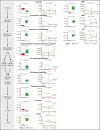Storage of red blood cells in alkaline PAGGGM improves metabolism but has no effect on recovery after transfusion
- PMID: 35477178
- PMCID: PMC9278290
- DOI: 10.1182/bloodadvances.2022006987
Storage of red blood cells in alkaline PAGGGM improves metabolism but has no effect on recovery after transfusion
Abstract
Additive solutions are used to limit changes that red blood cells (RBCs) undergo during storage. Several studies have shown better preservation of glucose and redox metabolism using the alkaline additive solution PAGGGM (phosphate-adenine-glucose-guanosine-gluconate-mannitol). In this randomized open-label intervention trial in 20 healthy volunteers, the effect of storage, PAGGGM vs SAGM (saline-adenine-glucose-mannitol), on posttransfusion recovery (PTR) and metabolic restoration after transfusion was assessed. Subjects received an autologous biotinylated RBC concentrate stored for 35 days in SAGM or PAGGGM. As a reference for the PTR, a 2-day stored autologous biotinylated RBC concentrate stored in SAGM was simultaneously transfused. RBC phenotype and PTR were assessed after transfusion. Biotinylated RBCs were isolated from the circulation for metabolomics analysis up to 24 hours after transfusion. The PTR was significantly higher in the 2-day stored RBCs than in 35-day stored RBCs 2 and 7 days after transfusion: 96% (90 to 99) vs 72% (66 to 89) and 96% (90 to 99) vs 72% (66 to 89), respectively. PTR of SAGM- and PAGGGM-stored RBCs did not differ significantly. Glucose and redox metabolism were better preserved in PAGGGM-stored RBCs. The differences measured in the blood bag remained present only until 1 day after transfusion. No differences in RBC phenotype were found besides an increased complement C3 deposition on 35-day RBCs stored in PAGGGM. Our data indicate that despite better metabolic preservation, PAGGGM is not a suitable alternative for SAGM because storage in PAGGGM did not result in an increased PTR. Finally, RBCs recovered from circulation after transfusion showed reversal of the metabolic storage lesion in vivo within a day. This study is registered in the Dutch trial register (NTR6492).
© 2022 by The American Society of Hematology. Licensed under Creative Commons Attribution-NonCommercial-NoDerivatives 4.0 International (CC BY-NC-ND 4.0), permitting only noncommercial, nonderivative use with attribution. All other rights reserved.
Figures








Similar articles
-
An improved red blood cell additive solution maintains 2,3-diphosphoglycerate and adenosine triphosphate levels by an enhancing effect on phosphofructokinase activity during cold storage.Transfusion. 2010 Nov;50(11):2386-92. doi: 10.1111/j.1537-2995.2010.02700.x. Transfusion. 2010. PMID: 20500561
-
In vitro measures of membrane changes reveal differences between red blood cells stored in saline-adenine-glucose-mannitol and AS-1 additive solutions: a paired study.Transfusion. 2014 Mar;54(3):560-8. doi: 10.1111/trf.12344. Epub 2013 Jul 22. Transfusion. 2014. PMID: 23869602 Free PMC article.
-
Stored red blood cell susceptibility to in vitro transfusion-associated stress conditions is higher after longer storage and increased by storage in saline-adenine-glucose-mannitol compared to AS-1.Transfusion. 2015 Sep;55(9):2197-206. doi: 10.1111/trf.13138. Epub 2015 May 13. Transfusion. 2015. PMID: 25968419 Free PMC article.
-
Impact of G6PD status on red cell storage and transfusion outcomes.Blood Transfus. 2019 Jul;17(4):289-295. doi: 10.2450/2019.0092-19. Blood Transfus. 2019. PMID: 31385801 Free PMC article. Review.
-
Survival of the fittest?--survival of stored red blood cells after transfusion.Cell Mol Biol (Noisy-le-grand). 2004 Mar;50(2):197-203. Cell Mol Biol (Noisy-le-grand). 2004. PMID: 15095790 Review.
Cited by
-
Red Blood Cell Storage: From Genome to Exposome Towards Personalized Transfusion Medicine.Transfus Med Rev. 2023 Oct;37(4):150750. doi: 10.1016/j.tmrv.2023.150750. Epub 2023 Aug 2. Transfus Med Rev. 2023. PMID: 37574398 Free PMC article. Review.
-
Supercooled storage of red blood cells slows down the metabolic storage lesion.Res Sq [Preprint]. 2025 Feb 27:rs.3.rs-5256734. doi: 10.21203/rs.3.rs-5256734/v1. Res Sq. 2025. PMID: 40060052 Free PMC article. Preprint.
-
Metabolic reprogramming under hypoxic storage preserves faster oxygen unloading from stored red blood cells.Blood Adv. 2022 Sep 27;6(18):5415-5428. doi: 10.1182/bloodadvances.2022007774. Blood Adv. 2022. PMID: 35736672 Free PMC article.
-
Blood-storage duration affects hematological and metabolic profiles in patients with sickle cell disease receiving transfusions.J Clin Invest. 2025 Jul 3;135(17):e192920. doi: 10.1172/JCI192920. eCollection 2025 Sep 2. J Clin Invest. 2025. PMID: 40608427 Free PMC article. Clinical Trial.
-
Red Blood Cell Omics and Machine Learning in Transfusion Medicine: Singularity Is Near.Transfus Med Hemother. 2023 Mar 8;50(3):174-183. doi: 10.1159/000529744. eCollection 2023 Jun. Transfus Med Hemother. 2023. PMID: 37434999 Free PMC article. Review.
References
-
- Luten M, Roerdinkholder-Stoelwinder B, Schaap NPM, de Grip WJ, Bos HJ, Bosman GJ. Survival of red blood cells after transfusion: a comparison between red cells concentrates of different storage periods. Transfusion. 2008;48(7):1478-1485. - PubMed
-
- Zeiler T, Müller JT, Kretschmer V. Flow-cytometric determination of survival time and 24-hour recovery of transfused red blood cells. Transfus Med Hemother. 2003;30(1):14-19.
-
- Dumont LJ, AuBuchon JP. Evaluation of proposed FDA criteria for the evaluation of radiolabeled red cell recovery trials. Transfusion. 2008;48(6):1053-1060. - PubMed
-
- Bolton-Maggs PHB. SHOT conference report 2016: serious hazards of transfusion - human factors continue to cause most transfusion-related incidents. Transfus Med. 2016;26(6):401-405. - PubMed
-
- Goldman M, Webert KE, Arnold DM, Freedman J, Hannon J, Blajchman MA; TRALI Consensus Panel . Proceedings of a consensus conference: towards an understanding of TRALI. Transfus Med Rev. 2005;19(1):2-31. - PubMed
Publication types
MeSH terms
Substances
Grants and funding
LinkOut - more resources
Full Text Sources
Research Materials
Miscellaneous

